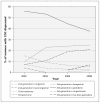Higher risk of venous thrombosis associated with drospirenone-containing oral contraceptives: a population-based cohort study
- PMID: 22065352
- PMCID: PMC3255137
- DOI: 10.1503/cmaj.110463
Higher risk of venous thrombosis associated with drospirenone-containing oral contraceptives: a population-based cohort study
Abstract
Background: Combined oral contraceptives are a common method of contraception, but they carry a risk of venous and arterial thrombosis. We assessed whether use of drospirenone was associated with an increase in thrombotic risk relative to third-generation combined oral contraceptives.
Methods: Using computerized records of the largest health care provider in Israel, we identified all women aged 12 to 50 years for whom combined oral contraceptives had been dispensed between Jan. 1, 2002, and Dec. 31, 2008. We followed the cohort until 2009. We used Poisson regression models to estimate the crude and adjusted rate ratios for risk factors for venous thrombotic events (specifically deep vein thrombosis and pulmonary embolism) and arterial thromboic events (specifically transient ischemic attack and cerebrovascular accident). We performed multivariable analyses to compare types of contraceptives, with adjustment for the various risk factors.
Results: We identified a total of 1017 (0.24%) venous and arterial thrombotic events among 431,223 use episodes during 819 749 woman-years of follow-up (6.33 venous events and 6.10 arterial events per 10,000 woman-years). In a multivariable model, use of drospirenone carried an increased risk of venous thrombotic events, relative to both third-generation combined oral contraceptives (rate ratio [RR] 1.43, 95% confidence interval [CI] 1.15-1.78) and second-generation combined oral contraceptives (RR 1.65, 95% CI 1.02-2.65). There was no increase in the risk of arterial thrombosis with drospirenone.
Interpretation: Use of drospirenone-containing oral contraceptives was associated with an increased risk of deep vein thrombosis and pulmonary embolism, but not transient ischemic attack or cerebrovascular attack, relative to second- and third-generation combined oral contraceptives.
Figures

Comment in
-
Risk of venous thromboembolism with oral contraceptives.CMAJ. 2011 Dec 13;183(18):E1278-9. doi: 10.1503/cmaj.111614. Epub 2011 Nov 7. CMAJ. 2011. PMID: 22065358 Free PMC article. No abstract available.
References
-
- Mosher WD, Martinez GM, Chandra A, et al. Use of contraception and use of family planning services in the United States: 1982–2002. Adv Data 2004;(350):1–36 - PubMed
-
- Taylor T, Keyse L, Bryant A. Contraception and sexual health, 2005/06. London (UK): National Statistics; 2006
-
- Lawrie TA, Helmerhorst FM, Maitra NK, et al. Types of progestogens in combined oral contraception: effectiveness and side-effects. Cochrane Database Syst Rev 2011;(5):CD004861. - PubMed
-
- Vandenbroucke JP, Rosing J, Bloemenkamp KW, et al. Oral contraceptives and the risk of venous thrombosis. N Engl J Med 2001;344:1527–35 - PubMed
-
- Gomes MP, Deitcher SR. Risk of venous thromboembolic disease associated with hormonal contraceptives and hormone replacement therapy: a clinical review. Arch Intern Med 2004; 164:1965–76 - PubMed
MeSH terms
Substances
LinkOut - more resources
Full Text Sources
Medical
Research Materials
